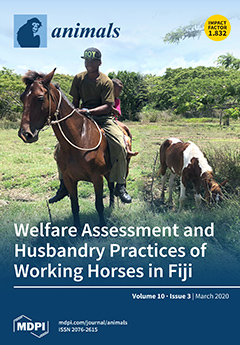To investigate the effects of dietary starch structure (amylose/amylopectin ratio, AR) on serum glucose absorption metabolism and intestinal health, a total of ninety weaned piglets (Duroc × (Yorkshire × Landrace)) were randomly assigned to 5 dietary treatments and fed with a diet containing different AR (2.90, 1.46, 0.68, 0.31, and 0.14). The trial lasted for 21 d. In this study, the growth performance was not affected by the dietary starch structure (
p > 0.05). Diets with higher amylose ratios (i.e., AR 2.90 and 1.46) led to a significant reduction of the serum glucose concentration at 3 h post-prandium (
p < 0.01), while high amylopectin diets (AR 0.31 and 0.14) significantly elevated The expression of gene s at this time point (
p < 0.01). High amylopectin diets also increased the apparent digestibility of crude protein (CP), ether extract (EE), dry matter (DM), gross energy (GE), and crude ash (
p < 0.001). Interestingly, diet rich in amylose (AR 2.90) significantly elevated the butyric acid content (
p < 0.05) and decreased the pH value (
p < 0.05) in the cecal digesta. In contrast, diet rich in amylopectin (i.e., AR 0.14) significantly elevated the total bacteria populations in the cecal digesta (
p < 0.001). Moreover, a high amylopectin diet (AR 0.14) tended to elevate the mRNA level of fatty acid synthase (
FAS,
p = 0.083), but significantly decreased the mRNA level of sodium-dependent glucose transporter 1 (
SGLT1, p < 0.05) in the duodenal and jejunal mucosa, respectively. These results suggested that blood glucose and insulin concentrations were improved in high AR diets, and the diet also helped to maintain the intestinal health.
Full article






